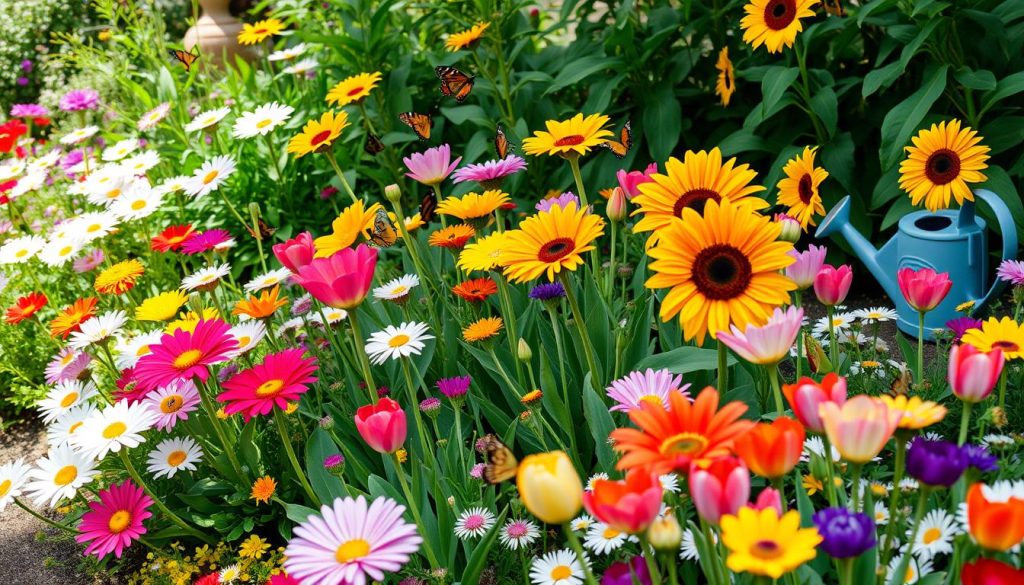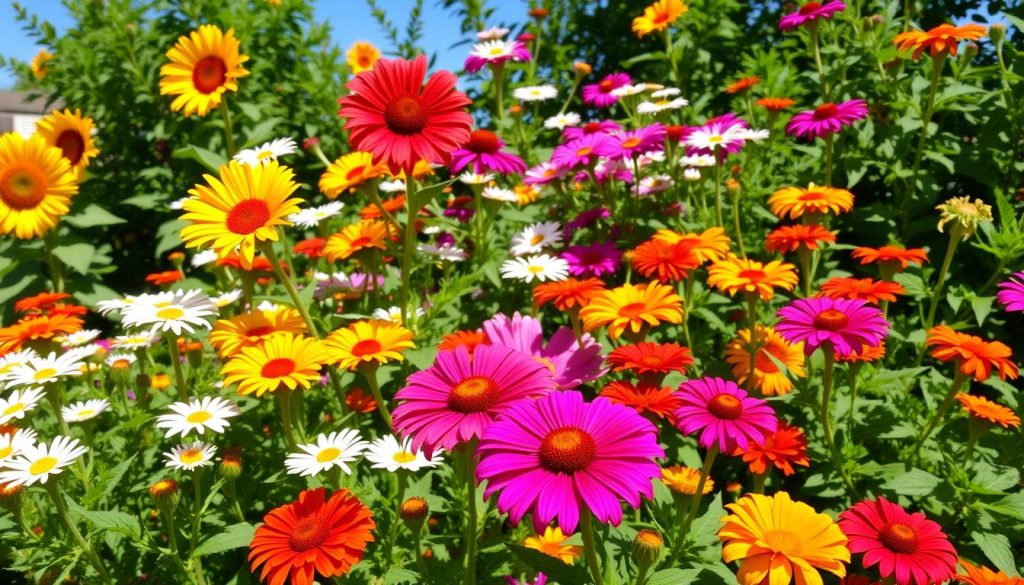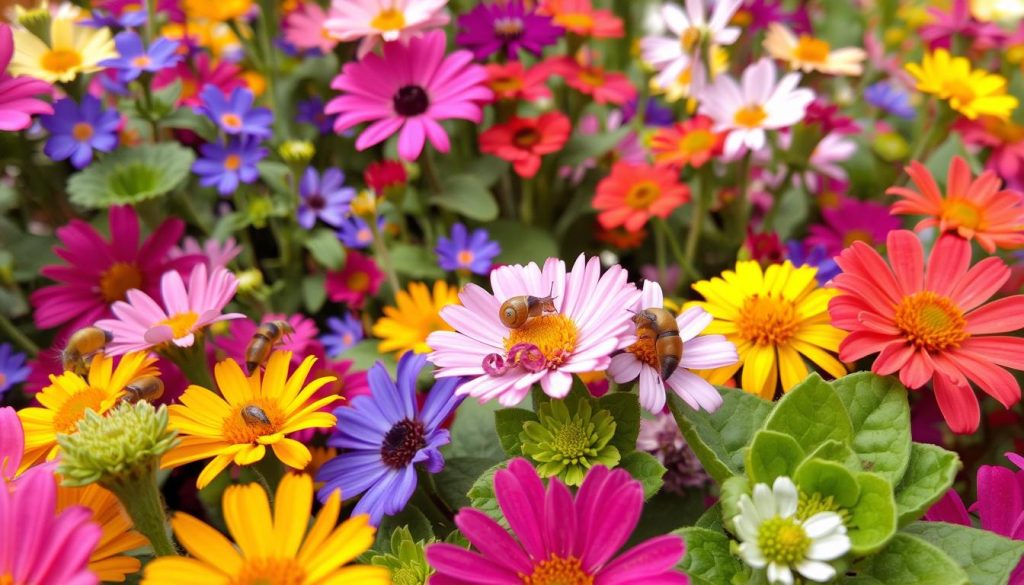Starting your journey in flower gardening can be very rewarding, especially for beginners. You don’t need a big space to grow flowers. Even a small patio, a big backyard, or a windowsill can be perfect. This guide will help you learn the basics of flower gardening.
We’ll cover everything from picking the right spot to choosing easy-to-grow flowers. You’ll learn how to create a beautiful and thriving garden.

Key Takeaways
- Flower gardening can be a rewarding and enjoyable hobby for beginners
- Understanding basic gardening concepts, such as sun exposure and soil quality, is crucial for success
- Choosing the right location and easy-to-grow flower varieties can set you up for a flourishing garden
- Proper planting techniques, watering, and fertilizing can help your flowers thrive
- Maintaining your garden through the seasons and addressing common challenges can ensure long-term success
Understanding the Basics of Flower Gardening
Gardening with flowers is a fun and rewarding hobby for beginners. To start, it’s key to know about different flower types, growing zones, and seasonal patterns.
Types of Garden Flowers
Flowers in gardens fall into two main groups: perennials and annuals. Perennials live for more than a year, while annuals grow and die in one season. Beginners often choose perennials like zinnias and sunflowers for their easy growth and bright colors. Annuals, such as marigolds, add color in the summer.
Understanding Growing Zones
The USDA Hardiness Zone Map is crucial for gardeners. It shows climate zones that affect plant growth. Knowing your zone helps pick flowers that will do well in your area.
Seasonal Growing Patterns
Flower gardens have their own seasons. Perennials take time to grow, sometimes 2-3 years. Annuals bloom quickly, from summer to late summer. Knowing these patterns helps plan your garden for constant beauty.
Learning about flower gardening basics is essential. It includes flower types, growing zones, and seasons. With this knowledge, you can choose the best flowers and care for them to thrive.
Choosing the Perfect Location for Your Garden
Choosing the right spot for your flower garden is key. The right location can make your garden vibrant and healthy. As you start your gardening journey, remember these important factors to find the perfect spot.
Sunlight is crucial for most flowers. They need at least 6 hours of direct sunlight a day. Some, like leafy greens, need only 4-6 hours. Root vegetables, however, need 6-8 hours of sun.
Soil quality is also vital. Your soil should drain well and be 2-3 feet deep. If it takes too long to drain after rain, consider raised beds or containers. A soil test can help you understand your soil’s composition and pH level, guiding you to make the right amendments.
Choosing the perfect garden location can be tough for beginners. But with some observation and planning, you can create a beautiful flower garden. Start small and grow your garden as you gain experience. The key to success is balancing sunlight, soil, and water for your flowers to thrive.
Essential Tools and Materials for Beginning Gardeners
Starting your gardening journey can be both thrilling and daunting. To make a strong start, having the right tools and materials is key. This includes basic gardening tools, essential soil amendments, and watering equipment. Let’s look at the main things you need to create a vibrant flower garden.
Basic Gardening Tools
- Foxglove gardening gloves – Durable and breathable for comfortable hand protection
- Ratcheting anvil pruners – Increase cutting strength for trimming and shaping plants
- Tabor GG12 Anvil Loppers – Powerful tool for cutting branches up to 2 inches in diameter
- Radius Garden 203 Pro Ergonomic Steel Digging Fork – Ideal for digging dense soil
- Garrett Wade Tulip Trowel – Perfect for transplanting bedding plants and herbs
- King of Spades Model 38 Balling Spade – Unbreakable handle for heavy-duty digging
- Tabor Tools Adjustable Metal Rake – Adjustable head for versatile raking tasks
- Rogue Garden Hoe 575G – High-grade tempered steel head for efficient weeding
Soil and Fertilizer Requirements
Healthy soil is crucial for a blooming flower garden. Choose a good potting soil that gives your plants the nutrients they need. Also, adding compost can make the soil better by improving its structure and drainage.
Watering Equipment
Watering right is key for your garden’s health. Look into Tuff-Guard flexible hoses and Bon Aire Ultimate Hose Nozzles for flexible watering. For more precise watering, the Dramm One-Touch Rain Wand is great. The Bloem Deluxe Watering Can is also useful for targeted watering.
Growing Flowers For Beginners: Getting Started
Starting your flower garden journey is exciting but can feel overwhelming. With the right steps, you can create a stunning garden. Let’s explore the key steps to begin growing beautiful flowers.
The first step is selecting the right flowers. Think about your growing zone, sun exposure, and when you want them to bloom. Annuals like marigolds, nasturtiums, and petunias are great for beginners. They add color and need little care. Perennials like pansies, sweet alyssum, and sweet peas come back every year.
After picking your flowers, it’s time to map out your planting process. Draw a plan for your garden, considering sun and shade. This ensures your flowers grow well. When planting, follow the spacing on the tags and dig the right-sized holes.
The last important step is preparing your garden bed. Make sure your soil drains well and is rich with compost. Add mulch to keep moisture in and weeds out.
With your flowers, plan, and bed ready, you’re set for a beautiful garden. Be patient, enjoy the journey, and feel free to try new things as you learn.
Soil Preparation and Garden Bed Setup
Getting your soil ready for a flower garden is key to a beautiful display. Before planting, test your soil and make any needed changes. This ensures your flowers have the best growing conditions.
Testing and Improving Soil Quality
Start by testing your soil to find out its pH level, nutrient content, and composition. Use soil amendments like compost or limestone to improve it. Tilling the soil to 2-4 inches deep helps mix in these changes, making it better for your plants.
Creating Proper Drainage
Good drainage is crucial for your garden. If your soil is heavy, think about raised beds or adding organic matter. Solarization can also kill weeds before you plant. After preparing, add mulch to keep moisture in and weeds out.
By preparing your garden bed well, you’re setting your flowers up for success. With the right soil testing and care, your plants will thrive and look great.
Best Easy-to-Grow Flowers for Novice Gardeners
Starting a flower garden is exciting, especially for beginners. We’ve picked the best flowers for new gardeners. These plants are easy to grow and need little care. They’re great for making a colorful and lively garden, even if you’re new to gardening.
Zinnias: Vibrant and Carefree
Zinnias are loved for their bright colors and simple care. They come in many colors, like the cheerful Profusion series and the elegant Queeny Lime Orange. These flowers love full sun and can be planted directly in the garden after the last frost.
Cosmos: Delicate and Effortless
Cosmos are perfect for beginners. They add a light touch to any garden with their airy blooms, like the stunning Sea Shells variety. They can be started indoors or directly in the garden. They’re easy to care for and can grow well in different soils.
- Sunflowers: Sunny and Uplifting
- Marigolds: Fragrant and Pest-Resistant
- Petunias: Cascading and Versatile
- Nasturtiums: Edible and Trailing
These are just a few flowers that are great for beginners. By picking easy plants and following simple gardening tips, even new gardeners can grow beautiful flowers. You’ll enjoy watching your garden grow and flourish.

Planting Techniques and Timing
When growing flowers, you can choose between direct sowing and transplanting seedlings. Knowing the difference between these methods helps you pick the best way for your garden.
Direct Sowing vs Transplanting Seedlings
Direct sowing means planting seeds right in the garden. It’s great for sunflowers, marigolds, zinnias, and nasturtiums. These flowers do well when planted directly in the soil.
Transplanting seedlings starts seeds indoors and then moves them outside. This is best for pansies, petunias, and cosmos. These flowers are more delicate and need a stronger start.
Spacing Guidelines
It’s important to space plants correctly for their health and growth. Always follow the spacing on the seed packet or plant tag. This ensures your flowers have enough room to grow.
As a rule, seed planting and transplanting seedlings should be 6 to 12 inches apart. Taller flowers like black-eyed Susans and sweet alyssum might need up to 18 inches of space.
Essential Watering and Fertilizing Tips
Proper watering and fertilizing are key for a successful flower garden. Here are some important tips to keep your flower bed thriving:
Watering Schedule
Flower gardens need about 1-2 inches of water each week. This can come from rain or you watering them. Water deeply to reach the roots, not just the surface. Change your watering schedule based on weather, soil, and plant needs. This ensures your flowers get the right moisture.
Fertilizer Application
Adding a balanced fertilizer to your garden boosts plant nutrition and growth. Use a slow-release fertilizer and follow the instructions, usually every 4-6 weeks. This keeps your flowers healthy and blooming.
- Choose a fertilizer with a N-P-K ratio that fits your flower types.
- Organic fertilizers like compost or bone meal offer a natural way to feed your plants.
- Don’t over-fertilize, as it can make plants grow too much foliage and fewer flowers.
By following these watering and fertilizing tips, you’ll create a beautiful and healthy flower garden. It will flourish season after season.
Common Gardening Challenges and Solutions
Growing a beautiful flower garden is rewarding, but it has its challenges. Gardeners face pests and diseases that can harm their plants. Knowing how to solve these problems helps keep gardens healthy and vibrant.
Pest Management
Pests like aphids, slugs, and snails can damage flowers. To fight these pests, gardeners use organic methods. This includes insecticidal soaps, introducing beneficial insects, or using diatomaceous earth.
Disease Prevention
Diseases like powdery mildew can harm flowers quickly. Keeping the garden clean and providing good airflow helps. Also, removing infected plants and choosing disease-resistant varieties is key.
By tackling pests and diseases, gardeners can keep their flower beds looking great. This ensures a beautiful garden all season long.

Maintaining Your Flower Garden Through Seasons
Keeping your flower garden vibrant needs careful seasonal care. Each season brings different needs for your garden to flourish. Knowing what your plants need in each season helps keep your garden looking great all year.
Spring Preparation
Spring is when you prepare your garden for growth. First, remove any winter debris. Then, check your soil and add compost or fertilizer to feed your plants. Prune any overgrown or damaged perennials to encourage new growth.
Summer Gardening
In summer, focus on watering regularly, removing dead flowers, and controlling pests and weeds. Use a slow-release fertilizer to help plants grow and bloom. Mulching keeps the soil moist and weeds away.
Fall Cleanup
- When fall arrives, get your garden ready for winter. Cut back any perennials that have stopped flowering.
- Remove fallen leaves and debris to stop disease and pests from staying.
- Add mulch around plants to keep roots warm and protect from frost.
Winter Protection
Protecting your perennials in winter is crucial. Mulch around plants to keep roots warm. Cover delicate plants with burlap or a frost blanket during cold spells. This way, your garden will be ready to bloom again in spring.
Following a seasonal care routine is vital for a beautiful year-round gardening experience. With some effort and attention, your flower garden can flourish in every season.
Deadheading and Pruning Basics
Keeping a flower garden alive needs more than just planting and watering. Learning deadheading and pruning is key. These methods help your plants bloom continuously and stay healthy all season.
Deadheading: The Key to Extended Blooms
Deadheading means cutting off old flowers from a plant. It offers many benefits:
- It makes plants bloom more by focusing energy on flowers, not seeds
- It stops plants from spreading where they shouldn’t
- It keeps your garden neat and clean
- It lowers disease risk by removing old, dying flowers
To deadhead right, use pruners or scissors to cut off old flowers. Cut just above a healthy leaf. Start in late spring and do it every few days for the best blooms.
Pruning: Shaping and Maintaining Plant Health
Pruning means cutting off parts of a plant like stems or leaves. It helps:
- Make plants bushier and flower more
- Get rid of damaged or dead parts
- Keep the plant’s shape and size right
Prune when it’s time, usually in early spring or late fall. Use sharp pruners and cut just above a leaf node or bud.
Learning deadheading and pruning will keep your garden looking great all season. Spend a bit of time on these tasks, and you’ll get a beautiful garden that blooms for a long time.
Creating Beautiful Flower Arrangements
Making stunning floral arrangements from your garden can be very rewarding. Whether it’s a vibrant bouquet or home decor with cut flowers, learning flower arrangement can make any space better. Here are some tips to help you create stunning floral pieces.
Think about the shape and balance of your arrangement. Asymmetrical designs, with a romantic or bohemian feel, are very popular. They add interest and movement. Also, choose a vase that’s wide enough to hold the stems you’ll need.
Using sustainable materials like chicken wire is a great idea. It’s reusable and eco-friendly. A 12-inch square piece of chicken wire works well for a vase with a 3-4 inch opening.
When placing flowers, start with foliage, then add focal flowers, and end with filler blooms. Odd numbers of flowers, like 3 or 5, look better. Also, use flower food and change the water every 2-3 days to keep your flowers fresh.
Before you go to the garden or market, plan your color scheme. This will help you choose flowers that match and create a balanced arrangement. Seasonal blooms are always a good choice because they’re fresh and vibrant.
Preparing your flowers right is key to their lasting beauty. Remove leaves and damaged petals, and make fresh cuts to the stems. The right container, like straight-sided vases for tulips or heavy vessels for tall blooms, can also enhance your arrangement.
Conclusion
Starting your gardening journey is exciting. It’s not just about growing flowers; it’s about the journey itself. Every challenge and experience teaches you something new. Celebrate each small victory along the way.
Success in gardening doesn’t happen overnight. But with hard work, creativity, and a willingness to learn, you’ll find joy in growing your garden. Your garden will flourish, bringing you happiness and fulfillment.
Learning is key to becoming a great flower grower. Always be curious and eager to learn. Try new techniques and expand your knowledge. This will help you grow and improve in your gardening journey.
Enjoy the little wins and the moments of wonder. Success is not just about the end result. It’s about the joy you find in the process. Every flower that blooms in your garden connects you to nature and the seasons.
Embrace this journey with passion. Let your love for flower growing grow into a lifelong adventure. Enjoy the journey and the beauty it brings to your life.